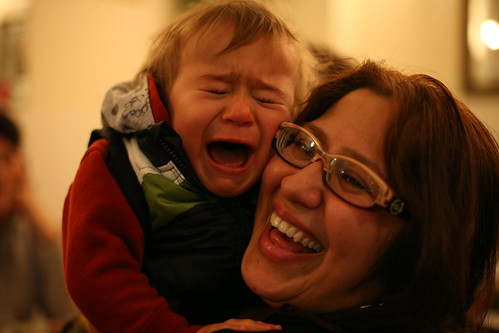 |
| Photo credit: Robert Scoble on Flickr |
But showing emotion is sometimes a little easier said than done. Where do you even begin? If you’re having trouble, it may help to use these four steps:
- Identify the emotion you’re trying to show. For the purpose of the example, let’s go with fear. But of course this could be anything.
- Write down some associated words/common traits of that emotion. There are two sources you can use to try to figure these out—your experience, and The Emotion Thesaurus (or, ideally, both). The idea is to develop a list of related words or descriptors of an emotion. You'll want to draw on your experience to determine how exactly that emotion will affect your character. For fear, that might mean feeling cold, increased heart rate, clammy palms, prickling, jumpiness, hyperventilating, etc. The nice thing about The Emotion Thesaurus is that the list is developed for you, so you can skip right on over to the next step...
- Choose a couple best suited for the situation and your character. Emotions affect everyone differently, and different levels of emotion (nervousness versus outright terror, for example) may affect the same person in different ways. Once you have your list prepared, you want to take a couple traits or reactions that you think best fit the scenario and your character, and use them together. For the sake of the example, I’m going to use feeling cold, an increased heart rate and shaking.
- Rewrite using your new words. Taking the words you've chosen from step three, rewrite the emotion with more impact.
I was terrified as I grabbed my phone.Using the steps above, you could end up with something like...
My heart rammed against my ribcage. Ice breathed down the back of my neck as I snatched my phone. My fingers were shaking so badly that I hit the wrong number and had to start over...You get the idea. The goal, in the end, is to write emotion without explicitly stating it. With the right combination of characteristics, imagery, thoughts and actions, your readers should be able to infer the emotion through context.
What other tips do you have for showing emotion effectively?
Twitter-sized bites:
Having trouble showing emotion in your writing? Here are four easy steps to get you on the right track. (Click to tweet)
Do you have trouble writing emotion? Writer @Ava_Jae shares four easy steps to showing emotion effectively. (Click to tweet)








13 comments:
This is very helpful, I am a very logical person so I have trouble writing emotions because 95% of the time reactions and emotions are not logical.
Glad to hear you found it helpful, Lauren! You're right that emotions tend not to be based in logic, particularly when you're the one experiencing them. I do like to think, however, that you can logically figure out your characters emotions based on their personalities and the situation. It just sometimes takes a little extra tweaking and reworking. :)
I'll be starting to edit my MS in the next few weeks and every time you post something about editing, I scribble it all down. This is no exception.
:) I love editing. Good luck! If you have any specific questions, let me know—I might be able to dig something out of the archives for you.
This is a great way to refrain from "telling", and can really make a difference to a reader. I know when I figure something out based on a handful of clever words, rather than just hearing "So and so was ___", I'm much happier.
I find this especially interesting, mostly because emotion is something I struggle with writing the most. Still, I've noticed concise writing seems to be better, and inevitably more words are used when not stating the emotion outright. I guess the really hard part is trying to find the most precise way to describe something without going on and on... Tricky.
My fingers dance across the keyboard to write this comment to you. Avoiding cliches with this is something I find difficult. If I read a cliche it has zero effect on me and it would have been better to write nothing. So careful choice of words, I think.
Agreed! I'd much rather infer a character's feelings than be told. :)
I agree that concise writing is usually stronger—and I don't think this is an exception. You really only need a couple characteristics to get an emotion across without telling, and you definitely don't want to ramble on and on about anything. :)
Careful choice of words is a great suggestion. You're right that clichés are easy to use (and pretty much ineffective), so it's always a good idea to push ourselves to write something that isn't a cliché. (Although, I usually wait until revisions to worry about that step, but nevertheless).
That's great! ^_^
Me too but a lot of my stories deal directly with subverting cliches.
Awesome. :)
Post a Comment